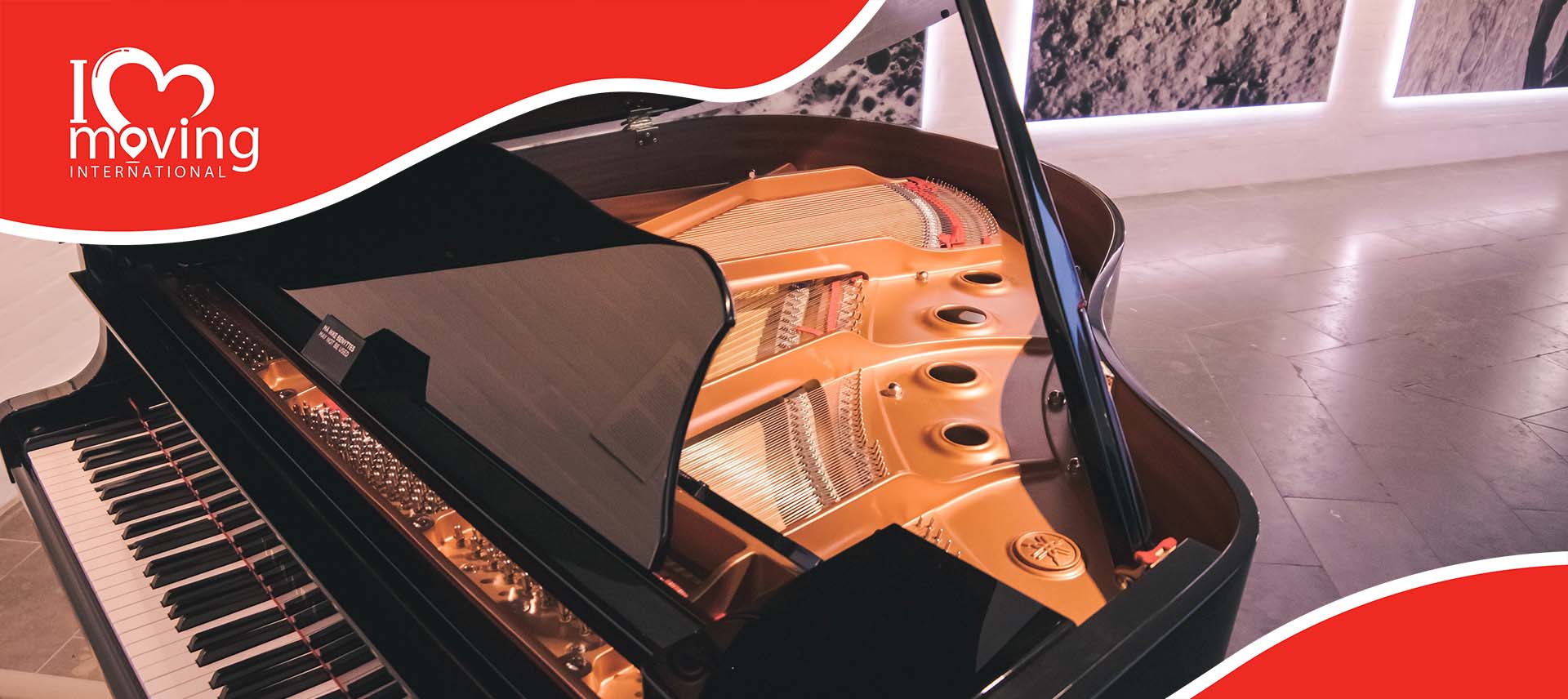When it comes to moving internationally, one of the most problematic parts of the relocation process is shipping large items from your home, especially the big and valuable musical instruments. If you’re planning on moving overseas and not sure how to move a piano yourself, this article will provide you with the ultimate guide on how to do it.

Why Is Moving a Piano Such a Problematic Issue?
Large musical instruments are some of the most difficult items for transporting, especially when you’re moving abroad. There are many reasons why this whole process is problematic and why it needs to be done carefully and with a lot of attention.
First of all, they are very fragile and can easily get damaged if not handled properly. Damage is a scenario you should avoid at all costs, considering how expensive they are. Taking time to research the best way to move a piano is vital and will save you from any potential risk and prevent possible injuries.
Gather All the Necessary Equipment To Help You Out With Transporting It Through Your Home and Down the Stairs
Before you start moving a piano yourself, you should prepare a relocation checklist of all the equipment you need for transporting the valuable instrument. There is not a single chance you’ll finish this task successfully without the proper equipment to protect both yourself and the item you are transporting.
What equipment do you need to move a piano? Make sure you’ve gathered all of the following items to avoid any relocation mistakes or cause damage:
- Blankets are needed to keep the instrument intact and protect its surfaces and edges.
- Dolly is crucial for navigating your instrument through the house. One of the great things about these tools is that they have wheels designed to keep your floors undamaged.
- Boards are kind of like a dolly, as they have the same purpose. Since they don’t come with handles, you’re going to need appropriate straps with a wheel attached to them.
- Straps come in three versions – ratchet, locking, and shoulder ones. They can extend the use of your arms and will facilitate heavy lifting or crossing the stairs. One thing to remember is that your straps must be flexible and well adjusted to the weight of your load.
- Stair ramps are necessary in case you have stairs in your home, and you have to carry such a large and heavy load down them. They can really be lifesavers in situations like this.
Take into consideration that you’re going to have to rent a vehicle for transporting this item, including a van or a truck ramp, as well as relocating straps and loads of weightlifting.
Get Supplies That Will Protect the Instrument and Prevent Damage
You should also gather materials for protecting and securing each piece of the instrument as if you were packing fragile items. Transporting instruments can cause substantial damage if not protected properly. You can use a vinyl wrap as a protective cover for the lid and the pedals, and they will be easy to remove after you’re done with the transportation. Once you’ve gathered everything from the list, you can count on an efficient move.
On Youtube, you can find many different videos on this topic or even DIY videos of people creating their custom-made equipment.
How To Prepare for the Piano’s Transportation?
No matter what your reasons for relocating are, you have to organize well for each task of the process. Take time for your relocation preparations, especially when it comes to these complicated tasks, such as relocating a giant musical instrument. Here are some of the things to keep in mind while organizing your move.
Clear the Path in Your Home for the Transportation
Once you’ve gathered all the needed equipment for the move, start thinking about the easiest way to transport the instrument through your house. Create the best strategy to go through your home with this enormous load.
Get anything that might become an obstacle out of the way, such as bulky furniture, carpets, cables, and other similar items. A good strategy will reduce any additional relocation stress throughout the move process.
You Need To Know the Type of Instrument You’re Moving
When preparing for a move, you have to know what type of piano you have in your home. Pianos come in different sizes and differ by many criteria, meaning they have to be handled differently. For example, grand pianos are the bulkiest ones and are usually used for concert halls. The upright ones are the type most people have in their homes.
Overcoming Problems With Transporting Pianos
When you’re done with the preparations, as we’ve suggested above, you can start considering how to properly take the instrument out of your home and move it across the world. How do you move a piano easily? Here are some tips that might help you with overcoming the problem of transporting this precious item.
How to Move an Upright Piano?
If you have this type at home, you’re probably wondering, ”How do you move an upright piano?”. When it comes to moving an upright piano, you have to make sure the keys and the pedals are well protected. It should be covered with a blanked, taped, and secured. Then you should cover it with relocating blankets by placing them on the front, back, and side of the instrument. It needs to be protected well so it can be safely placed onto the dolly.
How to Move a Grand Piano?
When moving a grand piano, you have to be extra careful when securing the top lid of the instrument. If you know how to do it, take a screwdriver to disassemble the pedals and legs. Once the legs are separated, wrap everything in blankets and secure them with tape. Ensure everything is safely covered and secured before you lift it. You’re going to need a board as a transporting tool designed to strap the instrument before it’s placed on the dolly. Place it onto a board, secure it, and carefully start pushing.
Find as Many Helpers as Possible
One thing you have to keep in mind is that it’s going to be impossible to conquer the task of relocating such a heavy and large instrument on your own. Even with all the adequate equipment, you have to assemble a team of helpers who can assist you. When lifting the instrument, you should have someone on all its sides. Everyone should be super cautious to prevent getting injured when trying to lift the instrument.
If you’re not planning on hiring professional help, you could invite your friends and family members to help you out with the relocation tasks. That could be a fun activity for quality time together before you move overseas. Invite them all over for lunch and drinks, and later they could manage packing for the move with you.

How Much Does It Cost to Move a Standing Piano?
When you’re relocating to another country, shipping such large items abroad can be quite pricey. If you’re relocating on a low budget, you have to be extra careful with where your money goes. The first thing you should figure out is the weight of the instrument. Usually, the grand ones weigh up to 1,200 pounds or more, while the upright ones usually weigh somewhere up to 500 pounds.
According to Fixr, relocating such a huge item may cost anywhere between $700 to $5,000, depending on the distance and type of transportation option you choose. Once you know exactly how much it weighs, you can contact an overseas shipping company and ask them to provide you with a reliable quote. Depending on which country you’re relocating to, make sure to ask them about any specific documents for relocating abroad you might need.

Don’t Know How to Move a Piano? Consider Hiring Professional Movers to Help You Out
As you’ve probably figured out throughout this article, relocating such an instrument is not an easy task, especially if you’re relocating abroad alone. We suggest you contact an international moving company, as they could offer you plenty of beneficial services. Every overseas moving company and its movers know how to handle relocating any problematic item from your household. They’ll also load and unload everything from the truck.
When relocating by the sea with professionals, they can offer you affordable prices for any service you might need. Taking into account that items like these musical instruments are costly, you’re going to ask them to provide you with relocation insurance as well. You can even ask the movers about their storage services but only agree if the units are climate controlled. This step is crucial since humidity can be catastrophic for such fragile instruments.
Companies like this have a team of experienced professionals that are well trained in packing services and the know-how to properly handle items that are super heavy yet fragile and require special treatment. So, you won’t have to worry about your thing staying safe if you decide to choose a reputable company.
Have the Instrument Tuned Once It Reaches Your New Home
This is just one of the tips you should keep in mind once you settle down and start living overseas. Your instrument will probably not be ready for use immediately after it arrives at your new home. It will probably go out of tune from the change of temperature and humidity in the truck and throughout shipping overseas, so be prepared to tune it at least three times in the first year. Once it is adapted to the new environment, you will be able to reduce the number and do it once or twice a year.

Find a Solution That Fits Your Preferences and Budget
We’ve provided you with our ultimate guide for relocating this instrument to a different country, and it’s totally up to you to figure out whether you are going to get assistance or not. You might find that doing everything on your own is the best choice, and you’ll find each of these tips super useful. Or you might realize that it is all too much work, and you won’t have time or energy to deal with choosing what to pack for the move and preparing everything for the transport. In that case, you should contact movers.
Whatever you choose to do, research your options well and figure out what fits your preferences and budget, so you don’t have trouble later with balancing finances abroad. It’s essential your relocation process goes smooth and stress-free.












